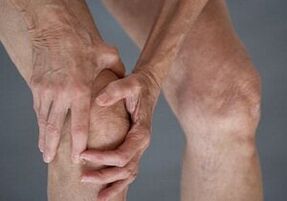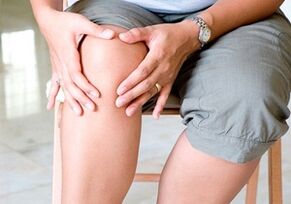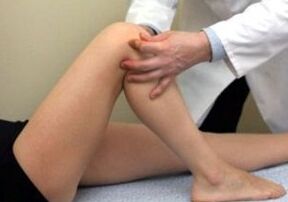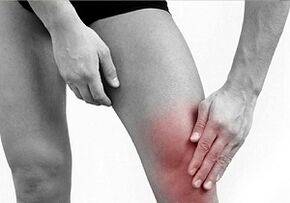
Knee osteoarthritis often occurs in patients with pathological changes in the tissues of the musculoskeletal system.Knee arthrosis is based on deformation of articular cartilage.Degenerative dystrophic disease of the knee, which constantly puts increasing pressure on the joint, is most often diagnosed in patients aged 40-50 years.Sometimes deformed joints manifest themselves during adolescence and early adulthood.
Restricted knee joint movement can disrupt its function and cause severe discomfort to the patient.Treatment is long, expensive and not always successful.It’s important to know how to prevent knee joint disease, how to treat it at home, and what you can do to restore the joy of sports.
Cause of disease
Knee arthritis is considered a multicausal disease.Often, this pathology is caused by a combination of factors that do not always have a clear cause.
There are two types of knee joint disease:
- primary;
- Secondary.
Classification is based on the principle of cause and effect.In some patients, articular cartilage is affected by multiple negative factors; it is not always possible to identify the driving force for the development of the pathology.
Treatment of knee joint disease of unknown cause is more complex and lengthy; knee joint problems can cause a lot of trouble and reduce quality of life.For this reason, doctors advise patients to prevent diseases and take preventive measures.
Main causes of illness:
- Primary form.Obvious dependence on risk factors.For most patients, knee problems are caused by sustained high loads on the area.Knee joint disease affects support workers, loaders and athletes;
- Secondary.Articular cartilage damage occurs in the context of systemic pathology.Degenerative dystrophic changes in the knee joint occur in the context of hemochromatosis, diabetes mellitus, rheumatoid arthritis and congenital curvatures of the lower limbs.Another reason is genetics: the disease appears in every generation.
Please pay attention!In some cases, doctors are unable to accurately determine the cause of knee joint disease.This form of pathology is called idiopathic.
Characteristic symptoms

The main symptoms of the disease:
- Knee pain when moving;
- Difficulty bending and straightening the knee in the morning;
- In severe cases, deep deformation may occur, with joint entrapment, subluxation, and dislocation;
- You will hear a characteristic clicking sound in your knees when performing certain movements.
The danger with pathology is that the mechanisms of development of knee arthrosis have not been fully studied.The last link affects the original factor, and the degenerate changes unfold with new vigor.With each rotation, the condition of the cartilage deteriorates, the tissue becomes less elastic, and the disease progresses again.In primary forms of pathology, it is difficult for physicians to identify the moment that drives the activation of negative changes.
Which doctor should I contact?
Joint deformity is a pathology that requires a comprehensive treatment approach.Not all patients know which doctor treats joint disease.
If you have signs of illness, visit:
- therapist(Conduct examinations to determine underlying diseases, consult experts in endocrine diseases and congenital diseases);
- Rheumatologist.He will determine the cause of the joint deformity and perform further studies on the affected area.Doctors will use conservative care, physical therapy, and at-home joint treatment;
- ArthrologistA rather rare specialty.Large clinics have highly qualified doctors; they understand the problems of joint disease and arthritis inside out.The main expertise is surgical intervention in complex cases and severe pathologies.Finding a good doctor is difficult: there are few experts;
- Orthopedic surgeon.Doctors help patients with advanced knee disease when conservative treatments are not enough.Plastic surgeons perform organ preservation surgeries and endoprosthetic surgeries.
At-home treatments
How to treat knee arthritis at home?Articular cartilage deformities in the knee area are difficult to overcome; the multi-etiological nature of the pathology constantly leads to new waves of disease.Regular treatment with medicines, massage, exercise therapy and folk remedies is required.Patients must adhere to dietary regulations and be disciplined while undergoing surgery and special exercises.
Many patients ask: "Why is treatment so expensive?" The reason is the use of non-steroidal anti-inflammatory compounds, chondroprotectants, gels, anti-inflammatory creams in monthly (or multiple) sessions.Obvious good results can only be achieved with regular use of effective medications.The later a patient seeks help, the longer and more expensive treatment will be, especially if complex surgery is required.
The main methods of treating knee arthritis:
- drug;
- physical therapy procedures;
- diet;
- Special exercises;
- massage;
- healthy lifestyle;
- vitamin therapy;
- Folk remedies.
Doctors always encourage patients to be disciplined and perform some therapeutic activities at home.Many methods require almost no material costs: what is important is the desire to defeat joint disease and the regularity of the surgery.
drug treatment

Take medications prescribed by your rheumatologist:
- Knee cartilage protectants - drugs that restore the elasticity and functionality of cartilage tissue;
- Nonsteroidal compounds relieve inflammation in the affected area;
- Creams, gels, ointments for knee arthrosis to improve circulation and relieve pain;
- Has active anti-inflammatory effects.They work faster than ointments;
- Vitamins, dietary supplements.Dietary supplements of calcium and magnesium are recommended to strengthen muscles and bones.
Massage and self-massage
The doctor will perform several in-office treatments and demonstrate basic techniques so that the patient can massage the problematic knee on his or her own.Effective action can improve the condition of damaged areas.
Use the palms of your hands, edges of your hands, fingertips, or fists to self-massage.Apply gentle pressure to the sore knee, maintaining firm pressure on the affected area: hard tapping, blowing, and actively kneading the tissue will often worsen the condition.
Basic techniques:
- The first stage is gentle clockwise stroking, and the second stage is counterclockwise circular motion;
- Place the palm of one hand on the sore knee and tap lightly with the fingertips of the other hand;
- Keep your palm in its original position and tap not with your fingers, but with the edge of your palm;
- Gently stroke your knees in circular motions, gradually increasing the pressure (but moderately);
- During treatment, massage the affected area twice a day for 10-15 minutes each time.For preventive purposes, a light massage every 7 days is enough.
suggestion!Before surgery, apply an anti-inflammatory ointment or gel to your sore knee.Use medications or homemade mixtures: the therapeutic effect increases.
therapeutic exercise
Doctors in an athletic therapy office will show you exercises and gymnastics to treat the knee joint that patients should do at home.Regular exercise can improve circulation to joint pain and help heal the joint or reduce negative symptoms.

How to proceed:
- Warm up sore areas: self-massage for 5 minutes;
- Sit in a comfortable chair: You should feel comfortable;
- First exercise: Gently rock the affected leg.IMPORTANT: Keep your legs off the floor and do so in small increments.Duration – 2 minutes;
- Second exercise.Place your feet on the floor.Lift the heel of your sore leg, rest on your toes, wait 6-7 seconds, and slowly lower yourself to full foot height.Rest for 20-30 seconds, then repeat the "stomping" exercise.The optimal frequency depends on how you feel; it is recommended that the feet and knees bear the load for up to three minutes;
- The third exercise.Doctors call it a "slapper."Starting position - sitting on a chair.Place your sore leg on your heel and your other leg firmly on the floor, tapping your toes gently and resting briefly between movements.Start with a sore knee and repeat a few times.
Many orthopedic surgeons and rheumatologists believe that treatments for knee arthritis that limit joint mobility are outdated.Most modern clinics offer rehabilitation services using special gymnastics.Through regular exercise, you can maintain the flexibility and mobility of cartilage tissue and joints.
Folk remedies and recipes
Proven home remedies:
- Herbal Infusions.Use nettles, chamomile, horsetail, birch leaves and buds;
- Apply with sunflower oil, dandelion tincture (yellow flower heads);
- Compress with a decoction of chamomile, celandine, fresh cabbage pulp (or whole leaves);
- Take fresh celery juice internally.Drink 1 tbsp.Lake 40 minutes before appointment, write 3 times a day;
- Made from steamed birch leaves and burdock;
- Honey massage.After surgery, apply burdock leaves to your sore knees.
Recommended diet

In order to effectively treat joint disease at home, it is important to adhere to certain nutritional rules.A nutritionist will tell you which dishes and products will keep your musculoskeletal system healthy.
Include in your menu more often:
- low-fat cheese;
- Sprouted wheat (buds up to 3 mm long);
- fermented dairy products;
- almond;
- bone broth aspic;
- Fresh and cooked vegetables are the basis of the diet;
- Jelly disks containing gelatin, which increases the elasticity of cartilage;
- bran bread;
- lean fish;
- Durum wheat pasta.
Minimum quantity allowed:
- muffin;
- red fruits and vegetables;
- Confectionary products.
prohibit:
- any alcohol;
- fat meat;
- citrus;
- Ready-made semi-finished meat products and canned food.
Precautions
Take care of your joints and unpleasant ailments like knee ailments won't bother you.If you notice pathological symptoms, contact your doctor as soon as possible before the joint tissue completely loses mobility and elasticity.Untimely treatment of advanced cases can lead to disability.
Prevent joint diseases:
- Reduce load on the legs during active exercise;
- Develop a diet that includes foods and dishes containing calcium, magnesium, and gelatin;
- If the job involves lifting or moving heavy objects, follow safety rules and do not lift loads that exceed certain limits;
- Practice regular self-massage to prevent joint disease, especially if you are under constant pressure on your legs;
- Eat right and limit “bad” foods;
- Weight control (excess weight means extra stress on joints);
- Regular examination and treatment of acute and chronic diseases.
Attention to the health of the musculoskeletal system ensures activity at any age.If you notice arthritis in your knee, talk to your doctor.Treating joint disease at home is an important factor in successful treatment.



















